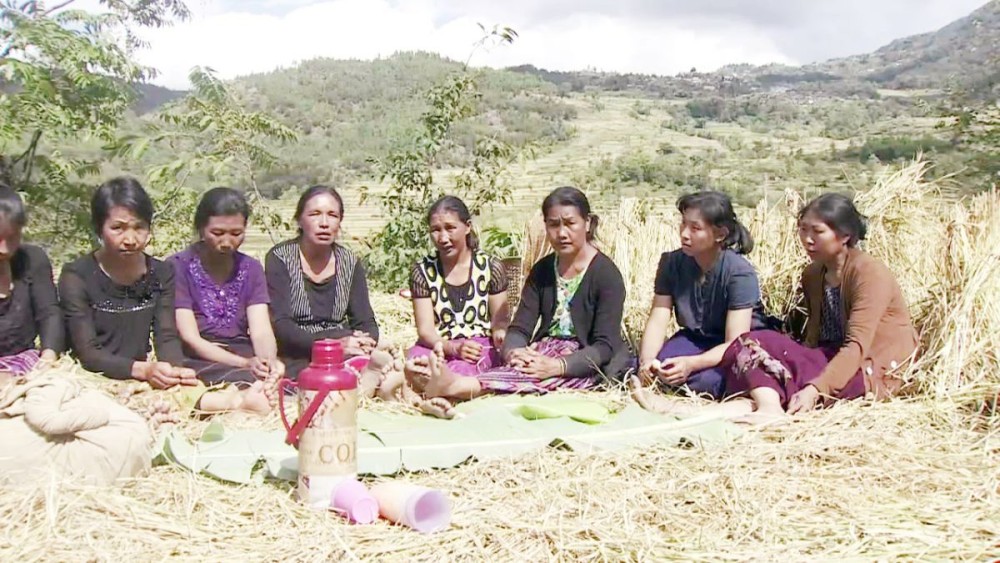A group of women SHG members. October 15 is the United Nations’ International Day of Rural Women. (Photo Courtesy/NSRLM)

Nagaland State Rural Livelihood Mission (NSRLM) provides training in agricultural techniques and time-saving machinery, besides granting loans and encouraging savings
Ketholeno Neihu
Dimapur | October 15
From monitoring mid-day meals in government schools in Mokokchung to standing up against taxation in Dimapur, rural women in Nagaland are mobilizing Self Help Groups (SHGs) to initiate social action, support one another and improve economies. Their contribution has become vital both in their homes and communities.
The Nagaland State Rural Livelihood Mission (NSRLM) has been providing much in terms of financial and mechanical help to the SHGs of Nagaland State to help them grow.
Thanks to loans from NSRLM, for instance, “every member in our SHG has been able to open our own bank account,” says Achü, an SHG member from Jakhama block.
Imonenla Imkong Phom, Program Manager, NSRLM observes that access to credit at minimal interest rates through micro-financing and internal lending through SHGs has helped members to reduce the burden of high debts. “The members are gradually able to come out of the trap of the local moneylenders who charge exorbitant interest rates,” she notes.
NRLM aims to reduce poverty by building strong grassroots institutions of poor (SHGs and their Village Level Organisation and higher level federations) by enabling poor households access to gainful self-employment and skilled wage employment opportunities, improving their livelihoods on a sustainable basis. Flagged off in 2013, it has reached 515 Villages in 29 Blocks under 9 District under Intensive Implementation in Nagaland.
“The impact of the programme has been profound,” shares Kethonino, a member of Noami SHG in Phesama Village. The SHG planted 100 banana saplings through financial assistance from NSRLM when they formed their SHG in 2014, which are producing great dividends now.
Shiholi, another SHG member, states, “We maintain our registers, conduct regular meetings and ensure repayment for loans on time through inter-lending funds that has been given to us through direct fund transfer in bank account.”
Furthermore, SHG led interventions have generated self-employment opportunities, financial aid to members which give them opportunities to diversify livelihoods. “The different livelihood activities undertaken by the SHGs are animal husbandry, kitchen garden, cardamom plantation, ginger plantation, paddy, pulses cultivation, fishery, handicrafts, horticulture, food processing, detergent making and private businesses such as petty shop, flea shop, catering, provision stores,” the NSRLM Program Manager informs.
“Many women have learnt the nuances of undertaking financial transactions and dealing with various stakeholders,” she adds.
“Although, many of us are unlettered, we rotate leadership responsibilities among ourselves to enable equal participation for every member,” Shiholi notes.
After Awola, a widow and mother of two, joined the women’s SHGs in her area, Purana Bazaar Dimapur, she received training in capacity building and leadership, counseling services on savings, training on micro-investment, credit and insurance.
“After my husband’s death, the SHG became my strength and support. I got the opportunity to sit on a plane when I attended an ICRB training in Hyderabad among thousands of women from across India,” she recalls. Today, Awola is able to make 30-40 business plans a month.
For many women, savings made round the year are shared in the year end during festive season. Every SHG collects Rs. 50-300 as membership fee from each member every month.
October 15 is the United Nations’ International Day of Rural Women. This year’s theme is ‘Sustainable infrastructure, services and social protection for gender equality and the empowerment of rural women and girls.’ The SHG model with help from the NRSLM is helping rural women in Nagaland achieve these goals.






